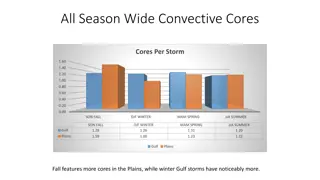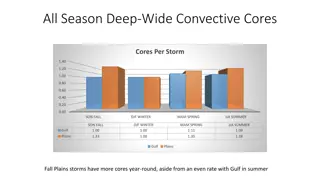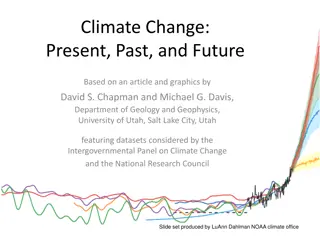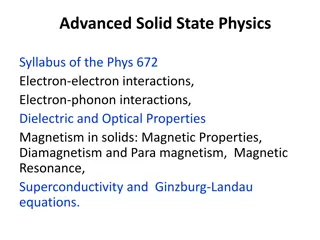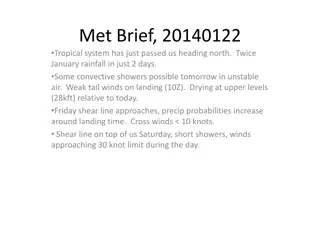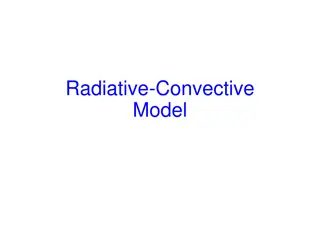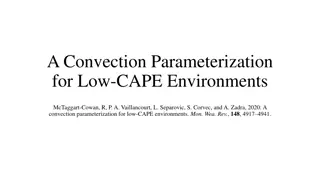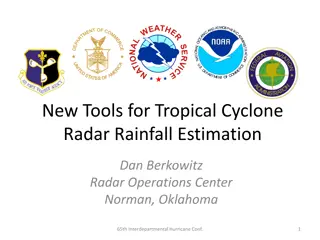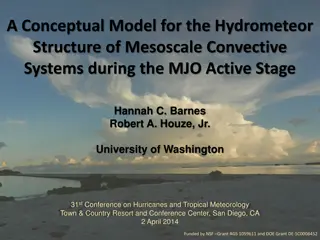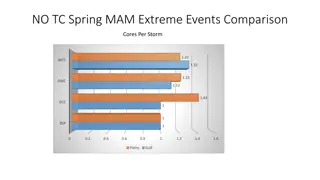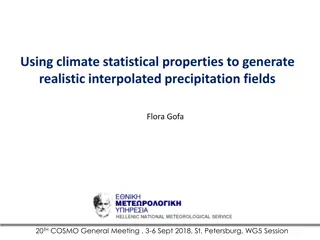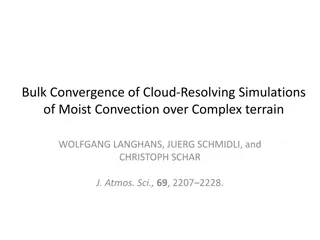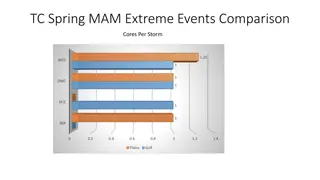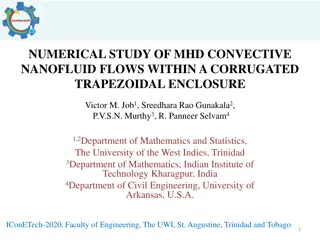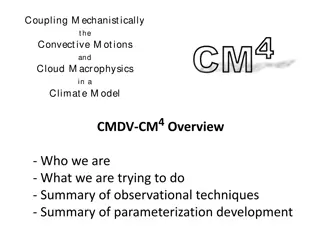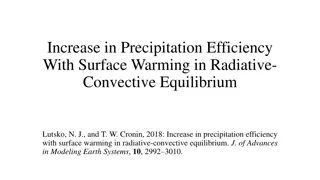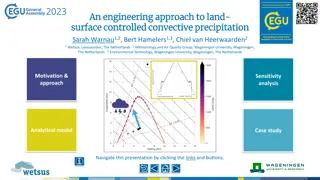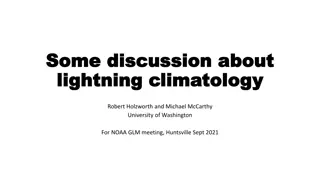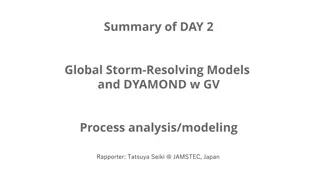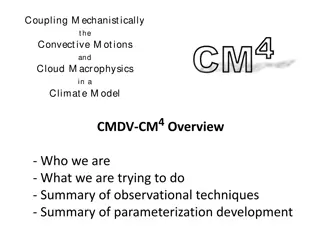Advancements in Solar-Terrestrial Research and Meteorology
The Solar-Terrestrial Centre of Excellence (STCE) focuses on ongoing activities and opportunities in the field of meteorology, with a special emphasis on Antarctica. Their annual meetings cover topics like water vapor feedback mechanisms, extreme weather events forecasting, cloud and precipitation s
0 views • 14 slides
Threads in Computing
Exploring the concepts of parallel, distributed, and concurrent computing processes and how threads, cores, and CPUs work together. Delve into the terminology, implementation in Java and C#, synchronization, and the importance of leveraging multiple cores for enhanced performance.
0 views • 24 slides
Precipitation in Meteorology
Precipitation in meteorology is the result of atmospheric water vapor condensing and falling to Earth, a vital element of hydrology. It can occur in liquid or solid forms through processes like evaporation, cooling, condensation, and droplet growth. Different geographic and climate conditions impact
0 views • 17 slides
CAPE and CIN Calculation in Atmospheric Modeling
Learn how to calculate Convective Available Potential Energy (CAPE) and Convective Inhibition (CIN) using the Weisman-Klemp sounding method. The procedure involves defining parcel properties, lifting the parcel level by level, and performing saturation adjustments. Explore the concepts of positive a
4 views • 14 slides
Comparison of Convective Cores in Gulf and Plains Regions
A detailed comparison of convective cores between Gulf and Plains regions across different seasons reveals interesting patterns. Gulf storms have more cores in the fall, with larger sizes and more cores in winter. The Plains see more cores in the spring season and have generally bigger storms year-r
1 views • 4 slides
Analysis of Seasonal Variations in Gulf Plains Convective Cores
The analysis reveals fascinating insights into Gulf Plains convective cores, showcasing variations in core numbers, average pixels per storm, pixels per core, and core sizes across different seasons. Deep-Wide cores dominate in the summer, while Gulf cores are larger in the fall. The study sheds lig
1 views • 4 slides
Dual-Pol Observations in NW Environment OLYMPEX Planning Meeting
The OLYMPEX planning meeting in Seattle on January 22, 2015 discussed the contribution of polarimetric S-band radar in rain estimation systems targeted by OLYMPEX. The use of specific differential phase (Kdp) helps in minimizing assumptions about drop size distribution, convective/stratiform distinc
1 views • 15 slides
Climate Change Through Paleoclimatology
This presentation delves into the study of past climates using proxy data such as corals and tree rings. By examining natural recorders like ice cores and fossilized pollen, scientists can reconstruct historical climate variations. The visuals showcase how data from sources like coral cores and tree
0 views • 40 slides
Introduction to Drude Model in Solid State Physics
Drude Model, formulated around 1900, explains the fundamental properties of metals such as electricity and heat. It proposes that electrons in metals behave like a classical electron gas, moving freely between atomic cores. The model considers the mean free path between electron collisions and estim
1 views • 39 slides
Heat-Related Illnesses in Sports Medicine
Hyperthermia is a condition where body temperature is elevated, posing risks like heat stress and heat-related illnesses. Proper knowledge of factors like temperature, humidity, and hydration is crucial for athletes and coaches to prevent such conditions during workouts. Metabolic heat production, c
2 views • 29 slides
Unstable Weather Alert: Tropical System Impact and Shear Line Approaching
Tropical system passing north, bringing heavy rainfall and unstable air. Expect convective showers, tailwinds on landing, and shifting precipitation patterns. Concerns about tropical showers, moisture levels, and shear line impact on landing and takeoff conditions. Images of weather situations provi
2 views • 10 slides
Detailed Overview of a Radiative-Convective Model for Weather Prediction
This detailed overview explores the components of a Radiative-Convective Model, covering convection, radiation transfer, cloud-radiation interaction, and surface fluxes. The model incorporates algorithms and parameterizations to simulate various cloud types, radiative transfer processes, and surface
1 views • 9 slides
Convection Parameterization for Low-CAPE Environments
Many global Numerical Weather Prediction systems face challenges predicting convective activity in low-CAPE environments. This study introduces a convection parameterization scheme based on moisture convergence to better represent convective effects. The scheme focuses on the triggering function, up
3 views • 38 slides
Advances in Tropical Cyclone Radar Rainfall Estimation
Reviewing past methods and introducing new tools for radar rainfall estimation in tropical cyclones. Discusses advancements in Dual Polarization rainfall estimation and NSSL's National Mosaic & Multi-Sensor Quantitative Precipitation Estimation. Includes insights on reflectivity-to-rainfall relation
0 views • 28 slides
Conceptual Model for Hydrometeor Structure of Mesoscale Convective Systems during MJO Active Stage
This study presented a conceptual model for characterizing the hydrometeor structure of Mesoscale Convective Systems (MCSs) during the Madden-Julian Oscillation (MJO) active stage. The research focused on the kinematic structure of MCSs and utilized radar data, compositing methodology, and convectiv
2 views • 24 slides
Design and Implementation of a Three-Phase Triangle Core Measurement Type Voltage Transformer
This paper presents the design and implementation of a new dry-type voltage measurement transformer using triangular cores. The innovative core design aims to save weight and space, reduce volume, minimize harmonic content and magnetic stray losses, and enhance energy efficiency. The proposed transf
0 views • 16 slides
Comparison of Extreme Weather Events in Different Seasons
An analysis of extreme weather events across spring, summer, and autumn, focusing on core aspects per storm, average pixels per storm, and stratiform versus convective distribution. The comparison provides insights into variations in weather patterns and intensity across the seasons.
0 views • 30 slides
The Planetary Boundary Layer in Atmospheric Science
The Planetary Boundary Layer (PBL) plays a crucial role in atmospheric dynamics, divided into surface, mixed, stable, and residual layers. During the day, the mixed layer experiences convective motions due to surface heating, while the stable layer dominates during the night. Understanding these lay
0 views • 18 slides
Enhancing Precipitation Interpolation Methods for High-Resolution Data Analysis
Accurate interpolation of precipitation data is crucial for various applications, especially in regions with limited data coverage like Greece. This study focuses on improving the creation of a precipitation atlas for Greece using daily observation analysis. By analyzing the reliability of the metho
0 views • 24 slides
Analysis of Cloud-Resolving Simulations Over Complex Terrain
Examining cloud-resolving simulations of moist convection over complex terrain using large eddy simulation (LES) and deep convective fluxes. The study includes characteristics of the simulations, numerical convergence, and turbulent diffusion. Results reveal insights into the behavior of convective
0 views • 20 slides
Solid Mixing Mechanisms and Equipment
Solid mixing involves processes like convective, shear, and diffusive mixing which randomize dissimilar particles in a system. Factors affecting solid mixing include particle size, distribution, and properties like density and elasticity. Various mechanisms like tumbling mixers are used for solid mi
1 views • 16 slides
Extreme Weather Events Comparison in Different Seasons
This dataset contains detailed comparisons of extreme weather events in Spring, Summer, and Autumn for different types of convective cores and stratiform regions. The data includes information on average pixels per storm, cores per storm, and stratiform versus convective ratios across the Plains and
0 views • 30 slides
Numerical Study of MHD Convective Nanofluid Flows within Corrugated Trapezoidal Enclosure
Study investigates the influence of sidewall inclination angle and Eckert number on unsteady flow and heat transfer in alumina-water and SWCNT-water nanofluids within a trapezoidal enclosure. Motivation stems from the heat transfer enhancement in trapezoidal geometries compared to rectangular ones,
0 views • 19 slides
Accelerating Critical OS Services in Virtualized Systems
The research discusses accelerating critical OS services in virtualized systems using flexible micro-sliced cores. Challenges in server consolidation, tackling virtual time discontinuity, shortening time slice, and dividing CPUs into pools are highlighted. The approach involves serving critical OS s
0 views • 19 slides
Coupling of Convective Motions and Cloud Macrophysics in Climate Model CMDV-CM4
This project led by Lawrence Berkeley National Laboratory aims to mechanistically couple convective motions and cloud macrophysics in the CMDV-CM4 climate model. Through observational techniques and parameterization development, they seek to evaluate and enhance current cloud representations, develo
1 views • 16 slides
Increase in Precipitation Efficiency with Surface Warming
The study examines how surface warming affects precipitation efficiency in radiative-convective equilibrium. Various factors influencing precipitation efficiency, such as microphysical processes and climate sensitivity, are discussed. Model experiments are conducted to test the sensitivity of precip
0 views • 33 slides
Probabilistic Weather Information in Aircraft Safety Recommendations
Subcommittee on Aircraft Safety (SAS) emphasizes the importance of understanding probabilistic weather information for better operational decisions in aviation. Recommendations include leveraging existing knowledge and conducting studies to improve user understanding and decision-making processes re
0 views • 12 slides
Engineering Approach to Enhancing Water Availability in the Mediterranean Basin
Explore an innovative engineering approach to addressing water scarcity in the Mediterranean Basin through regreening degraded areas using sea water evaporation technology. This presentation discusses the impact on convective triggering, surface evaporation, and technology development for sustainabl
0 views • 24 slides
Virtual Temperature in Meteorology
Virtual temperature (TV) is a crucial concept in meteorology, representing the temperature a dry air parcel would have under specific conditions. It allows for adjustments in convective potential energy assessments and is essential for interpreting Skew-T log-P diagrams. When calculated accurately,
1 views • 4 slides
WSU Cores Town Hall - Research Infrastructure Events
The WSU Cores Town Hall on February 16, 2021, featured core presentations, breakout rooms, and a platform to increase awareness of WSU's research infrastructure. The event showcased various cores such as Genomics, Proteomics, and more, highlighting their annual revenue and investments to support Uni
0 views • 38 slides
Magnetic Materials in Electrical Machines
The significance of iron cores in electrical machines like motors, generators, and transformers. Understand the behavior of ferromagnetic materials, the B-H curve, and magnetic domains in grain-oriented electrical steel. Discover why the flux density increases with iron cores due to the crystal latt
0 views • 34 slides
All Season Extreme Events Comparison
This data compares extreme weather events across all seasons, showcasing different core types per storm and their characteristics. The comparison includes broad stratiform events, deep convective cores, deep wide convective cores, and wide convective cores, highlighting differences in pixels per sto
0 views • 40 slides
Advanced Weather Forecasting and Meteorology Course Overview
Dive into the world of weather forecasting and advanced synoptic meteorology with Atmospheric Sciences 452. Taught by Professors Cliff Mass and Richard Steed, this course covers tools and techniques for forecasting, numerical weather prediction, and more. Explore topics such as convective systems, r
0 views • 5 slides
Understanding Adiabatic Parcel Rise in Atmospheric Dynamics
Explore the concept of adiabatic parcel rise in the atmosphere through informative visuals and explanations. Learn about the relationship between parcel density, atmospheric density, buoyancy force, and real-world examples of cloud formation. Discover the role of Convective Available Potential Energ
0 views • 23 slides
Analysis of Linux Scalability to Many Cores
This paper analyzes the scalability of Linux to many cores by investigating traditional kernel designs' efficiency on multicore architectures. The study conducted experiments with 8 different applications running on a 48-core computer, aiming to eliminate most kernel bottlenecks and enhance scalabil
0 views • 43 slides
Enhancing Learner Retention Strategies Through Varied Delivery Modes
Explore innovative learner retention strategies such as pre-course reading, flipped classrooms, reflective activities, and more. Assess their effectiveness in different delivery modes like online, synchronous, classroom, or blended learning. Dive into topics like buoyancy, thermodynamic diagrams, an
0 views • 8 slides
Understanding Virtual Potential Temperature and Buoyancy in Atmosphere
Discover the significance of virtual potential temperature and potential temperature in meteorology. Learn how these parameters impact the stability of the atmosphere, air density, and buoyancy forces driving turbulence. Explore the concept of mixed layers and convective processes influencing vertic
0 views • 9 slides
Lightning Climatology Insights and New Science Directions
Explore the latest discussions on lightning climatology by Robert Holzworth and Michael McCarthy from the University of Washington. Discover insights on group energies, relationships between GLM and WWLLN energies, and new research directions on aerosol influences on thunderstorms and sea spray effe
0 views • 11 slides
Global Storm-Resolving Models and DYAMOND with GV Process Analysis
Explore the latest advancements in storm-resolving models and process analysis with a focus on vertical motion, aerosols, convective strength, cloud microphysics, and more. Key topics include thermal plumes, convective organization, and impactful weather phenomena such as tropical cyclones and polar
0 views • 5 slides
Mechanistic Coupling of Convective Motions and Cloud Macrophysics
Explore the integration of convective motions and cloud macrophysics in the CMDV-CM4 climate model through observational techniques and parameterization development at Lawrence Berkeley National Laboratory. This project aims to improve the representation of shallow clouds, evaluate current models, a
0 views • 16 slides




